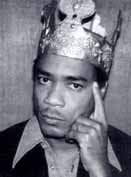'The b side' - The dub side
(Click here for music, music2)
[part one] Dub and politics on Jamaica was intimately intertwined, especially towards the end of the seventies. The music exploded on the dancehall scene at the same time as the neighbourhoods exploded in violence.
Dub and politics on Jamaica was intimately intertwined, especially towards the end of the seventies. The music exploded on the dancehall scene at the same time as the neighbourhoods exploded in violence.
As the reggae historican Steve Barrow expresses it; "Dub music represents 'the other side' of things figuratively. There is always a front page and a back side, an 'a side' and the 'b side'. The world is divided. Dub is the 'b side'."
Crossroads Dub, while being born out of reggae, is at the same time the early dark roots of hip hop as well as influencing the second-wave ska music. Dub being born from turmoil, became breeding ground for new music, creating a kind of musical crossroads.
Dub, while being born out of reggae, is at the same time the early dark roots of hip hop as well as influencing the second-wave ska music. Dub being born from turmoil, became breeding ground for new music, creating a kind of musical crossroads.
The last track of King Tubby's record was a unnamed dub version of "Satta Massa Gana", the famous single track of the Abyssinians (1969). It was informally known as the national hymn of the rastafari religion. Somewhat incorrectly translated from amharinijan it meant something like "thank and praise Haile Selassie". In the backgroundof the melody was the phrases "longing for the far-away far-away country".
King Tubby drastically cut down the hymn into a pulsing base and a distinct snare drum. The base beat was skewed and shifted out of both tone and position. The drums were like exploding thunder. The mirror world he created echoed the dissolving alliance between the Jamaican rastas and the Social Democrats. The utopia had been robbed by the gansters and left to die in the alley's of Trenchtown.
It was the music of hostile cross fire. Dub embraced the circumstances. It was everything at the same time. Dub was declaring, distorting and disengaging, all within the samebeat. It gave an embracing and fragmented voice to all the terrors the Jamaican nation could not express openly.
Photography?
How does this connect to our photography then? For me personally, I'm interested in our concern for fragments, shadows, traces and spaces of life and people that is so present in our pictures. This links to the lack of order in the dub music, how the original tunes are twisted and extended to show something more than the plain object. We are creating an impressionalistic view of what we want to communicate, not an objective reflection. A favourite photo that might illustrate this by Ulf is busskuren blev en fängelsehåla or this one by Tiro Leander called 'free falling' at photopoints.com.
So - do you agree that we have a streak of dub in our 'photography'?
Next: Ska music and Thatcher's Ghost Town.
Links and sources:
www.Dub.com
Lee 'scratch' Perry (at Furious)
King Tubby history (at Furious)
King Tubby Discography (at roots-archives.com)
What is dub? (by EnchantedForest)
Can't Stop Wont Stop (by Jeff Chang)
Photo of King Tubby linked from Furious.com)
Text: partially reworked from sources, partially written by author.






2 comments:
Very good stuff to have here
Thanks for your indepth article
Of course F photography is dub
;)
-urbano
You will be interested to know (I think) that here in Maine we speak our own strange version of English. It is dying, but still, you hear bits and pieces of the local lingo here and there. Dub is one of our words. Here, it means fool, or something like that. You can "dub around" meaning fool around, do nothing speacial, be kind of lazy. Or you can call someone a Dub -- meaning he is a lazy foolish sort. Or maybe just silly.
It is a light term, in either sense, noun or verb, used in a friendly fashion.
I always think I am just a dub with good equipment. and can frequently be found dubbing around in the darkroom.
So there's yet another take on the meaning of DUB. And yes, I think in some ways it fits :)
Jeanne
Post a Comment